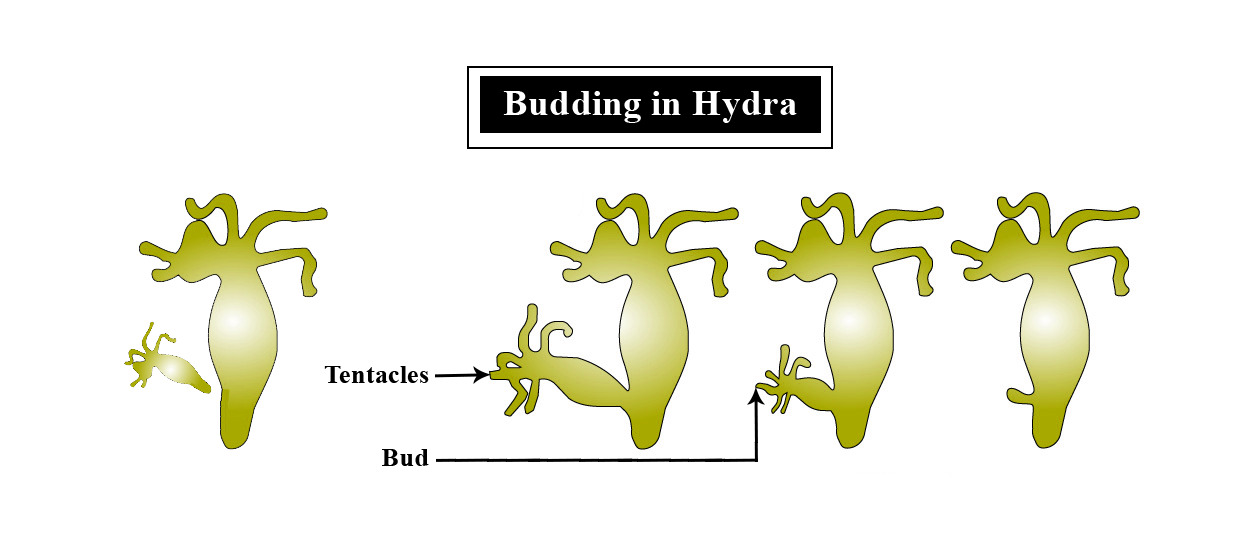
Budding method of asexual reproduction occurs in:
a)Amoeba
b)Plasmodium
c)Paramoecium
d)Hydra
Answer
575.7k+ views
Hint: This is a cnidarian having a tubular body that is composed of a head, distal end, and afoot at the end. These are very small, just a half-centimeter long found exclusively in freshwater.
Complete answer:
Hydra reproduces through both sexual and asexual reproduction. Budding is the type of asexual reproduction in which a bud develops or matures and becomes an adult. Budding in hydra involves a small bud that is developed from its parent hydra through the repeated mitotic division of its cells. Then the small bud receives its nutrition from the parent hydra and grows healthy. Developing small tentacles and the mouth indicates that the growth has started. Finally, in the end the small newly produced hydra gets separate from its parent body and becomes an independent organism.

Additional Information: -In preparation for reproduction, the amoeba will withdraw its pseudopodia and form a spherical shape. Mitosis is observed in the nucleus, and the cytoplasm divides at the center of the cell and separates, forming two daughter cells.
-The malaria parasites have male and female 'gametocyte' forms during one stage of their life-cycle, which play an important role in Plasmodium reproduction. These gametocytes linger in the blood of mammals, waiting to be ingested by mosquitoes. As soon as they get into the mosquito, they swing into action.
-During binary fission, one paramecium cell divides into two genetically identical offspring, or daughter cells. The micronucleus undergoes mitosis, but the macronucleus divides another way, called an amitotic, or non-mitotic, mechanism, this was defined according to Forney.
So, the correct answer is,’ Hydra’.
Note:
-Budding occurs in Hydra when it has plentiful resources. It is very common in plants and fungi. But Sometimes it can also be found in some invertebrate animals such as hydras and sponges.
- Budding refers to grafting the bud of one plant onto another in the field of agriculture and horticulture.
-Colonies of some bee species such as Apis dorsata have also exhibited budding behavior. Although It is rare in this bee species but can be seen when a group of workers leave the natal nest and construct a new nest near the natal one.
Complete answer:
Hydra reproduces through both sexual and asexual reproduction. Budding is the type of asexual reproduction in which a bud develops or matures and becomes an adult. Budding in hydra involves a small bud that is developed from its parent hydra through the repeated mitotic division of its cells. Then the small bud receives its nutrition from the parent hydra and grows healthy. Developing small tentacles and the mouth indicates that the growth has started. Finally, in the end the small newly produced hydra gets separate from its parent body and becomes an independent organism.

Additional Information: -In preparation for reproduction, the amoeba will withdraw its pseudopodia and form a spherical shape. Mitosis is observed in the nucleus, and the cytoplasm divides at the center of the cell and separates, forming two daughter cells.
-The malaria parasites have male and female 'gametocyte' forms during one stage of their life-cycle, which play an important role in Plasmodium reproduction. These gametocytes linger in the blood of mammals, waiting to be ingested by mosquitoes. As soon as they get into the mosquito, they swing into action.
-During binary fission, one paramecium cell divides into two genetically identical offspring, or daughter cells. The micronucleus undergoes mitosis, but the macronucleus divides another way, called an amitotic, or non-mitotic, mechanism, this was defined according to Forney.
So, the correct answer is,’ Hydra’.
Note:
-Budding occurs in Hydra when it has plentiful resources. It is very common in plants and fungi. But Sometimes it can also be found in some invertebrate animals such as hydras and sponges.
- Budding refers to grafting the bud of one plant onto another in the field of agriculture and horticulture.
-Colonies of some bee species such as Apis dorsata have also exhibited budding behavior. Although It is rare in this bee species but can be seen when a group of workers leave the natal nest and construct a new nest near the natal one.
Recently Updated Pages
Why are manures considered better than fertilizers class 11 biology CBSE

Find the coordinates of the midpoint of the line segment class 11 maths CBSE

Distinguish between static friction limiting friction class 11 physics CBSE

The Chairman of the constituent Assembly was A Jawaharlal class 11 social science CBSE

The first National Commission on Labour NCL submitted class 11 social science CBSE

Number of all subshell of n + l 7 is A 4 B 5 C 6 D class 11 chemistry CBSE

Trending doubts
What is meant by exothermic and endothermic reactions class 11 chemistry CBSE

10 examples of friction in our daily life

One Metric ton is equal to kg A 10000 B 1000 C 100 class 11 physics CBSE

1 Quintal is equal to a 110 kg b 10 kg c 100kg d 1000 class 11 physics CBSE

Difference Between Prokaryotic Cells and Eukaryotic Cells

What are Quantum numbers Explain the quantum number class 11 chemistry CBSE




